Broadband Free-Space Isolators (650 - 1000 nm)
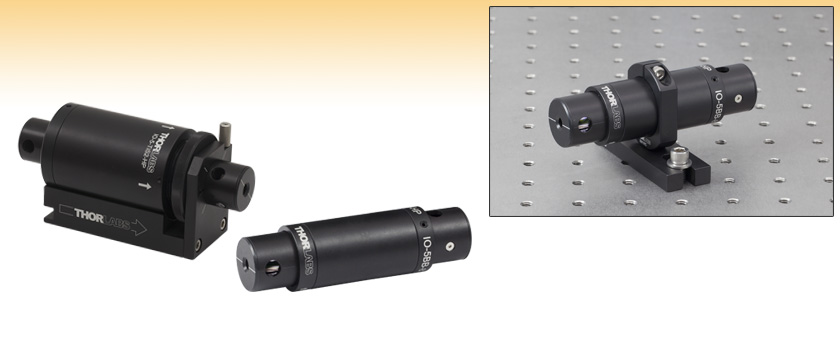
- Operating Ranges as Broad as 330 nm
- Fixed or Tunable Center Wavelengths
- Isolation Up to 40 dB and Powers Up to 40 W
- Custom Isolators Available Upon Request
IO-5-TIS2-HP
IO-5BB-800-HP
Removed
from Saddle
IO-5BB-800-HP
Shown in the Saddle (SM1RC) Mounted on an Optical Table
Using a BA1 Base with an SD1 1/4"-20 to 8-32 Counterbore Adapter

Please Wait
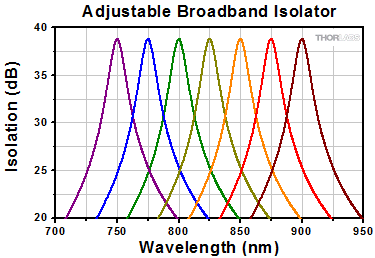
Figure 1.1 Our Adjustable Broadband Isolators can be tuned to maximize the peak isolation for any wavelength within a broad spectral range.
Custom Isolators
- Customizable Wavelength, Aperture, Max Power, Housing, Polarizers, and Operating Temperature
- Pricing Similar to Stock Units
- Wide Range of OEM Capabilities
- Please Contact Tech Sales or See Our Custom Isolators Page
Features
- Minimize Feedback into Optical Systems
- Free-Space Input and Output Ports
- Fixed or Tunable Wavelength Ranges
- At Least 30 dB Isolation Over a Broad Spectral Range
- Ø4.5 mm Max Beam Diameter
- Polarization-Dependent Input
Thorlabs is pleased to stock a variety of free-space optical isolators designed for broadband applications in the near infrared spectral range (650 - 1000 nm). Optical isolators, also known as Faraday isolators, are magneto-optic devices that preferentially transmit light along a single direction, shielding upstream optics from back reflections. Back reflections can create a number of instabilities in light sources, including intensity noise, frequency shifts, mode hopping, and loss of mode lock. In addition, intense back-reflected light can permanently damage optics. Please see the Isolator Tutorial tab for an explanation of the operating principles of a Faraday isolator.
| Table 1.2 Selection Guide for Isolators (Click Here for Our Full Selection) |
|---|
| Wavelength Range |
| 365 - 385 nm (UV) |
| 390 - 700 nm (Visible) |
| 690 - 1080 nm (NIR) |
| 1064 nm (Nd:YAG) |
| 1110 - 2100 nm (IR) |
| 2.20 - 4.55 µm (MIR) |
| Broadband |
| Fiber Isolators |
| Custom Isolators |
For broadband applications in the near infrared range, we offer two types of isolators. The first type, Adjustable Broadband Isolators, offers the user the ability to adjust the alignment of the input and output polarizers, allowing tuning of the center wavelength over a range greater than 200 nm and operating ranges as broad as 330 nm. The second type, Fixed Broadband Isolators (IO-5BB-800-HP), offers a nearly flat isolation of 30 dB in the 748 - 851 nm wavelength range, helping to preserve the temporal profile of the input pulse. Please see the Isolator Types tab for additional design details and representative graphs of the wavelength-dependent isolation. Each isolator's housing is marked with an arrow that indicates the direction of forward propagation.
Each isolator's housing is marked with an arrow that indicates the direction of forward propagation. In addition, all isolators have engravings that indicate the alignment of the input and output polarizers.
Thorlabs also manufactures isolators for fiber optic systems and wavelengths from the visible to the infrared (see Table 1.2). If Thorlabs does not stock an isolator suited for your application, please refer to the Custom Isolators tab for information on our build-to-order options, or contact Tech Sales. Thorlabs' in-house manufacturing service has over 25 years of experience and can deliver a free-space isolator tuned to your center wavelength from 365 nm to 4.55 µm. Our vertically integrated manufacturing structure allows us to offer Faraday rotators used in optical isolators. We offer a selection of Faraday rotators from stock and can provide custom Faraday rotators upon request.
Shaded regions on a graph represent the center wavelength tuning range of the isolator. With these isolators, the isolation and transmission curves will shift as the center wavelength shifts. If the graph is not shaded, then the isolator is non-tunable. Please note that these curves were made from theoretical data and that isolation and transmission will vary from unit to unit.
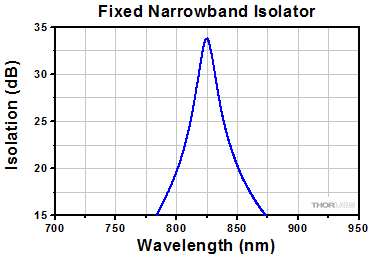
Fixed Narrowband Isolator
The isolator is set for 45° of rotation at the design wavelength. The polarizers are non-adjustable and are set to provide maximum isolation at the design wavelength. As the wavelength changes the isolation will drop; the graph shows a representative profile.
- Fixed Rotator Element, Fixed Polarizers
- Polarization Dependent
- Smallest and Least Expensive Isolator Type
- No Tuning
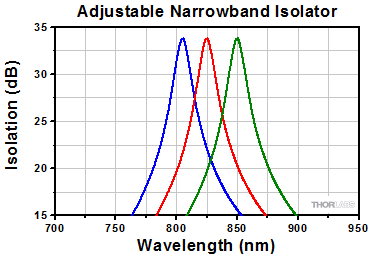
Adjustable Narrowband Isolator
The isolator is set for 45° of rotation at the design wavelength. If the usage wavelength changes, the Faraday rotation will change, thereby decreasing the isolation. To regain maximum isolation, the output polarizer can be rotated to "re-center" the Gaussian isolation curve. This rotation causes transmission losses in the forward direction that increase as the difference between the usage wavelength and the design wavelength grows.
- Fixed Rotator Element, Adjustable Polarizers
- Polarization Dependent
- General-Purpose Isolator
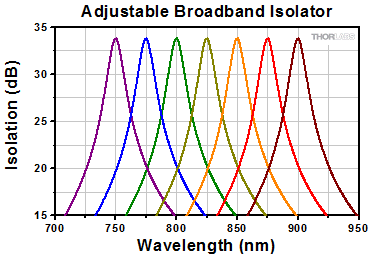
Adjustable Broadband Isolator
The isolator is set for 45° of rotation at the design wavelength. There is a tuning ring on the isolator that adjusts the amount of Faraday rotator material that is inserted into the internal magnet. As your usage wavelength changes, the Faraday rotation will change, thereby decreasing the isolation. To regain maximum isolation, the tuning ring is adjusted to produce the 45° of rotation necessary for maximum isolation.
- Adjustable Rotator Element, Fixed Polarizers
- Polarization Dependent
- Simple Tuning Procedure
- Broader Tuning Range than Adjustable Narrowband Isolators
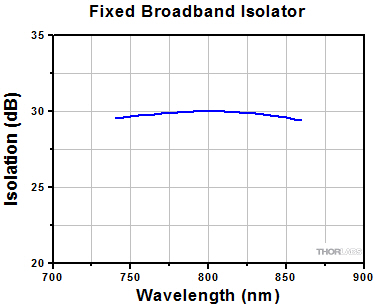
Fixed Broadband Isolator
A 45° Faraday rotator is coupled with a 45° crystal quartz rotator to produce a combined 90° rotation on the output. The wavelength dependences of the two rotator materials work together to produce a flat-top isolation profile. The isolator does not require any tuning or adjustment for operation within the designated design bandwidth.
- Fixed Rotator Element, Fixed Polarizers
- Polarization Dependent
- Largest Isolation Bandwidth
- No Tuning Required
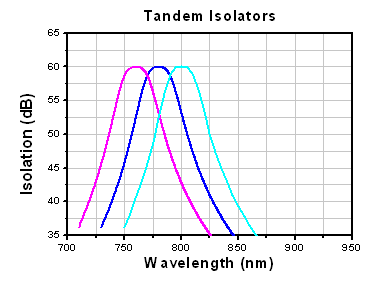
Tandem Isolators
Tandem isolators consist of two Faraday rotators in series, which share one central polarizer. Since the two rotators cancel each other, the net rotation at the output is 0°. Our tandem designs yield narrowband isolators that may be fixed or adjustable.
- Up to 60 dB Isolation
- Polarization Dependent
- Highest Isolation
- Fixed or Adjustable
Polarizer Types, Sizes, and Power Limits
Thorlabs designs and manufactures several types of polarizers that are used across our family of optical isolators. Their design characteristics are detailed here. The part number of given isolator has an identifier for the type of polarizer that isolator contains. For more details on how the part number describes each isolator, see the given isolator's manual.
Video Insight: How to Align an Optical Isolator
To ensure optimal transmission of optical power from the source, as well as effective suppression of reflections traveling back towards the source, the Faraday isolator must be properly aligned. Alignment is demonstrated using a previous generation IO-3-532-LP* polarization-dependent free-space isolator with a 510 nm to 550 nm operating range, an R2T post collar, a PL201 linearly polarized and collimated 520 nm laser, a S120C silicon power sensor, and a PM400 power meter.
If you would like more information about tips, tricks, and other methods we often use in the lab, we recommend our other Video Insights. In addition, our webinars provide practical and theoretical introductions to our different products.
*The I532M3 isolator, which covers the same operating range, can be used instead, along with an SM1RC slip ring.
Optical Isolator Tutorial
Function
An optical isolator is a passive magneto-optic device that only allows light to travel in one direction. Isolators are used to protect a source from back reflections or signals that may occur after the isolator. Back reflections can damage a laser source or cause it to mode hop, amplitude modulate, or frequency shift. In high-power applications, back reflections can cause instabilities and power spikes.
An isolator's function is based on the Faraday Effect. In 1842, Michael Faraday discovered that the plane of polarized light rotates while transmitting through glass (or other materials) that is exposed to a magnetic field. The direction of rotation is dependent on the direction of the magnetic field and not on the direction of light propagation; thus, the rotation is non-reciprocal. The amount of rotation β equals V x B x d, where V, B, and d are as defined below.
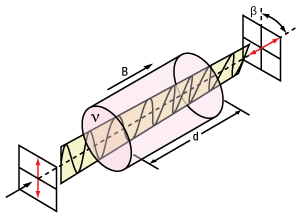
Click to Enlarge
Figure 54A Faraday Rotator's Effect on Linearly Polarized Light
Faraday Rotation
β = V x B x d
V: the Verdet Constant, a property of the optical material, in radians/T • m.
B: the magnetic flux density in teslas.
d: the path length through the optical material in meters.
An optical isolator consists of an input polarizer, a Faraday rotator with magnet, and an output polarizer. The input polarizer works as a filter to allow only linearly polarized light into the Faraday rotator. The Faraday element rotates the input light's polarization by 45°, after which it exits through another linear polarizer. The output light is now rotated by 45° with respect to the input signal. In the reverse direction, the Faraday rotator continues to rotate the light's polarization in the same direction that it did in the forward direction so that the polarization of the light is now rotated 90° with respect to the input signal. This light's polarization is now perpendicular to the transmission axis of the input polarizer, and as a result, the energy is either reflected or absorbed depending on the type of polarizer.
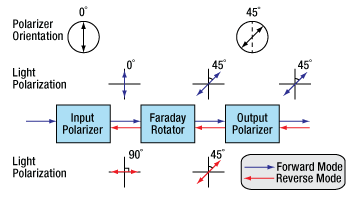
Click to Enlarge
Figure 54B A single-stage, polarization-dependent isolator. Light propagating in the reverse direction is rejected by the input polarizer.
Polarization-Dependent Isolators
The Forward Mode
In this example, we will assume that the input polarizer's axis is vertical (0° in Figure 54B). Laser light, either polarized or unpolarized, enters the input polarizer and becomes vertically polarized. The Faraday rotator will rotate the plane of polarization (POP) by 45° in the positive direction. Finally, the light exits through the output polarizer which has its axis at 45°. Therefore, the light leaves the isolator with a POP of 45°.
In a dual-stage isolator, the light exiting the output polarizer is sent through a second Faraday rotator followed by an additional polarizer in order to achieve greater isolation than a single-stage isolator.
The Reverse Mode
Light traveling backwards through the isolator will first enter the output polarizer, which polarizes the light at 45° with respect to the input polarizer. It then passes through the Faraday rotator rod, and the POP is rotated another 45° in the positive direction. This results in a net rotation of 90° with respect to the input polarizer, and thus, the POP is now perpendicular to the transmission axis of the input polarizer. Hence, the light will either be reflected or absorbed.
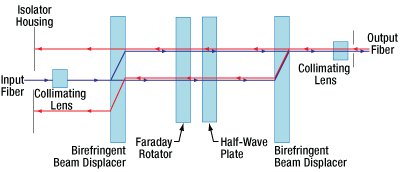 Click for Details
Click for DetailsFigure 54C A single-stage, polarization-independent isolator. Light is deflected away from the input path and stopped by the housing.
Polarization-Independent Fiber Isolators
The Forward Mode
In a polarization independent fiber isolator, the incoming light is split into two branches by a birefringent crystal (see Figure 54C). A Faraday rotator and a half-wave plate rotate the polarization of each branch before they encounter a second birefringent crystal aligned to recombine the two beams.
In a dual-stage isolator, the light then travels through an additional Faraday rotator, half-wave plate, and birefringent beam displacer before reaching the output collimating lens. This achieves greater isolation than the single-stage design.
The Reverse Mode
Back-reflected light will encounter the second birefringent crystal and be split into two beams with their polarizations aligned with the forward mode light. The faraday rotator is a non-reciprocal rotator, so it will cancel out the rotation introduced by the half wave plate for the reverse mode light. When the light encounters the input birefringent beam displacer, it will be deflected away from the collimating lens and into the walls of the isolator housing, preventing the reverse mode from entering the input fiber.
General Information
Damage Threshold
With 25 years of experience and 5 U.S. patents, our isolators typically have higher transmission and isolation than other isolators, and are smaller than other units of equivalent aperture. For visible to YAG laser Isolators, Thorlabs' Faraday Rotator crystal of choice is TGG (terbium-gallium-garnet), which is unsurpassed in terms of optical quality, Verdet constant, and resistance to high laser power. Thorlabs' TGG Isolator rods have been damage tested to 22.5 J/cm2 at 1064 nm in 15 ns pulses (1.5 GW/cm2), and to 20 kW/cm2 CW. However, Thorlabs does not bear responsibility for laser power damage that is attributed to hot spots in the beam.
Magnet
The magnet is a major factor in determining the size and performance of an isolator. The ultimate size of the magnet is not simply determined by magnetic field strength but is also influenced by the mechanical design. Many Thorlabs magnets are not simple one piece magnets but are complex assemblies. Thorlabs' modeling systems allow optimization of the many parameters that affect size, optical path length, total rotation, and field uniformity. Thorlabs' US Patent 4,856,878 describes one such design that is used in several of the larger aperture isolators for YAG lasers. Thorlabs emphasizes that a powerful magnetic field exists around these Isolators, and thus, steel or magnetic objects should not be brought closer than 5 cm.
Temperature
The magnets and the Faraday rotator materials both exhibit a temperature dependence. Both the magnetic field strength and the Verdet Constant decrease with increased temperature. For operation greater than ±10 °C beyond room temperature, please contact Technical Support.
Pulse Dispersion
Pulse broadening occurs anytime a pulse propagates through a material with an index of refraction greater than 1. This dispersion increases inversely with the pulse width and therefore can become significant in ultrafast lasers.
τ: Pulse Width Before Isolator
τ(z): Pulse Width After Isolator
Example:
τ = 197 fs results in τ(z) = 306 fs (pictured in Figure 54D)
τ = 120 fs results in τ(z) = 186 fs
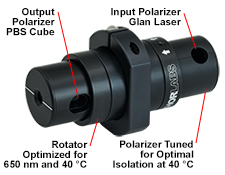
Click to Enlarge
Figure 32A Custom Isolator Example
Custom Adjustable Narrowband Isolator with Different Input and Output Polarizers Optimized for 650 nm Wavelength and 40 °C Temperature.
OEM Application Services
- Direct Integration to Laser Head Assemblies
- Combination Isolator and Fiber Coupling Units
- Minimum Footprint Packages
- Filter Integration
- Active Temperature Control and Monitoring
- Feedback Monitoring
- Environmental Qualification
- Private Labeling
- ITAR-Compliant Assembly
OEM and Non-Standard Isolators
In an effort to provide the best possible service to our customers, Thorlabs has made a commitment to ship our most popular free-space and fiber isolator models from stock. We currently offer same-day shipping on more than 90 isolator models. In addition to these stock models, non-stock isolators with differing aperture sizes, wavelength ranges, package sizes, and polarizers are available. In addition, we can create isolators tuned for specific operating temperatures and isolators that incorporate thermistors with heating or cooling elements for active temperature control and monitoring. These generally have the same price as a similar stock unit. If you would like a quote on a non-stock isolator, please fill out the form below and a member of our staff will be in contact with you.
Thorlabs has many years of experience working with OEM, government, and research customers, allowing us to tailor your isolator to specific design requirements. In addition to customizing our isolators (see the OEM Application Services list), we also offer various application services.
| Table 32B Specifications | |
|---|---|
| Parameter | Range |
| Wavelength Range | From 365 - 4550 nma |
| Aperture Sizes | Up to Ø15 mm |
| Polarization Dependence | Dependent or Independent |
| Max Powerb | Up to 2 GW/cm² |
| Isolation | Up to 60 dB (Tandem Units) |
| Operating Temperature | 10 - 70 °C |
Free-Space Isolators
We are able to provide a wide range of flexibility in manufacturing non-stock, free-space isolators. Almost any selection of specifications from our standard product line can be combined to suit a particular need. Table 32B shows the range of specifications that we can meet.
We offer isolators suitable for both narrowband and broadband applications. The size of the housing is very dependent on the desired maximum power and aperture size, so please include a note in the quote form below if you have special requirements.
Faraday Rotators
We offer Faraday rotators center wavelengths from 532 nm to 1550 nm. These are the same components used to make our isolators and rotate the polarization of incoming light by 45°. Please contact Tech Support if you require a Faraday rotator with a rotation angle or center wavelength outside of the aforementioned specifications.
| Table 32C Specifications | |
|---|---|
| Parameter | Range |
| Wavelength Range | From 633 - 2050 nma |
| Polarization Dependence | Dependent or Independent |
| Max Powerb (Fiber to Free-Space) | 30 W |
| Max Powerb (Fiber to Fiber) | 20 W |
| Operating Temperature | 10 - 70 °C |
Fiber Isolators
Thorlabs is uniquely positioned to draw on experience in classical optics, fiber coupling, and isolators to provide flexible designs for a wide range of fiber optic specifications. Current design efforts are focused on increasing the Maximum power of our fiber isolators at and near the 1064 nm wavelength. We offer models with integrated ASE filters and taps. Table 32C highlights the range of specifications that we can meet.
The fiber used is often the limiting factor in determining the Maximum power the isolator can handle. We have experience working with single mode (SM) and polarization-maintaining fibers (PM); single-, double- and triple-clad fibers; and specialty fibers like 10-to-30 µm LMA fibers and PM LMA fibers. For more information about the fiber options available with our custom isolators, please see Tables 32D and 32E.
In the spectral region below 633 nm, we recommend mounting one of our free-space isolators in a FiberBench system. A FiberBench system consists of pre-designed modules that make it easy to use free-space optical elements with a fiber optic system while maintaining excellent coupling efficiency. Upon request, we can provide select stock isolators in an optic mount with twin steel dowel pins for our FiberBench systems, as shown to the left.
We are also in the process of extending our fiber isolator capabilities down into the visible region. For more information, please contact Technical Support.
Custom Fiber Isolator
Custom Free-Space Isolator for Wavelengths Below 633 nm
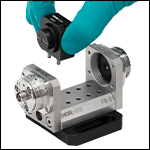
Click to Enlarge
Twin Steel Pins Insert into FiberBench
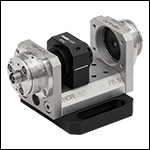
Click to Enlarge
Mounted Isolator
| Table 32D Polarization Independent Fiber |
|---|
| Table 32E Polarization Maintaining Fiber |
|---|
Make to Order Options
Tables 32F, 32G, 32H, and 32J provide information on some common isolator and rotator specials we have manufactured in the past. We keep the majority of the components for these custom isolators in stock to ensure quick builds, so these specials are available with an average lead time of only 2-4 weeks. Please use the Non-Stock Isolator Worksheet below for a quote.
| Table 32F Adjustable Narrowband Isolators |
|---|
| Table 32G Faraday Rotators |
|---|
| Table 32H Fixed Narrowband Isolators |
|---|
| Table 32J Fixed Broadband Isolators |
|---|
Custom Request Form
Request a custom isolator quote using the form below or by contacting us for more information at (973) 300-3000.
| Posted Comments: | |
Vladimir Zenin
(posted 2022-06-24 12:12:54.1) Hello Thorlabs!
I am wondering, is it possible to use IO-5BB-800-HP in a reversed direction? I.e., as for now, it rotates by 90 degrees in total (45 by Faraday rotator and 45 by half waveplate). If I put in in a reversed way, and rotate both polarizer to be aligned to the laser polarization, it should let the light go through without rotating the polarization (Faraday rotation will be compensated by the half-wave plate). Do you know whether it will work in this way, and are there any drawbacks? Thank you in advance! cdolbashian
(posted 2022-07-06 09:50:29.0) Thank you for reaching out to us Vladimir! I have reached out to you to get a clearer picture of what exactly you are trying to do. From our conversation, it seems like you want the HWP to pre-rotate the polarization state, so that after passing through Faraday rotator, the polarization state is the same as before the HWP; nominally using the HWP to cancel the effect of the Faraday rotator. Notably though, this only works in 1 direction, as the rotation directions will only be opposite unidirectionally, without also having to adjust the HWP. Vladimir Zenin
(posted 2021-05-11 03:31:48.463) Hello Thorlabs, I have a tunable Ti:Sapphire laser (wavelength 700-1000 nm), and want to upgrade it with an isolator. I am wondering whether a fixed broadband isolator
IO-5BB-800-HP will work? From the graph you provide, the isolation curve is quite flat, but I rather worry about transmission, which drops fast beyond the plot wavelength range. Do you have data (predictions) about performance of this isolator in 700-1000 nm wavelength range? Or do you recommend to order a custom (or tunable) isolator? Thank you in advance! YLohia
(posted 2021-05-13 11:02:20.0) Hello, I have reached out to you with theoretical extended range data directly. Kay Schaarschmidt
(posted 2019-10-02 16:10:23.767) Dear Sir or Madame,
I would like to know how much spectral Phase a pulse will aquire within the spectral Operation range of the IO-5BB-800-HP.
We are running a sub 20 fs laser System and I would like to estimate how much chirp will be acquired due to an Isolator.
Best regards,
Kay YLohia
(posted 2019-10-29 08:38:36.0) Hello Kay, thank you for contacting Thorlabs. The pulse will broaden according to the "Pulse Dispersion" section of the "Isolator Tutorial" tab on this page. We will reach out to you directly with more information. |
The following selection guide contains all of Thorlabs' Free-Space Optical Isolators. Click the colored bars below to to see specifications and options for each wavelength range and isolator type. Please note that Thorlabs also offers fiber optical isolators and custom optical isolators.
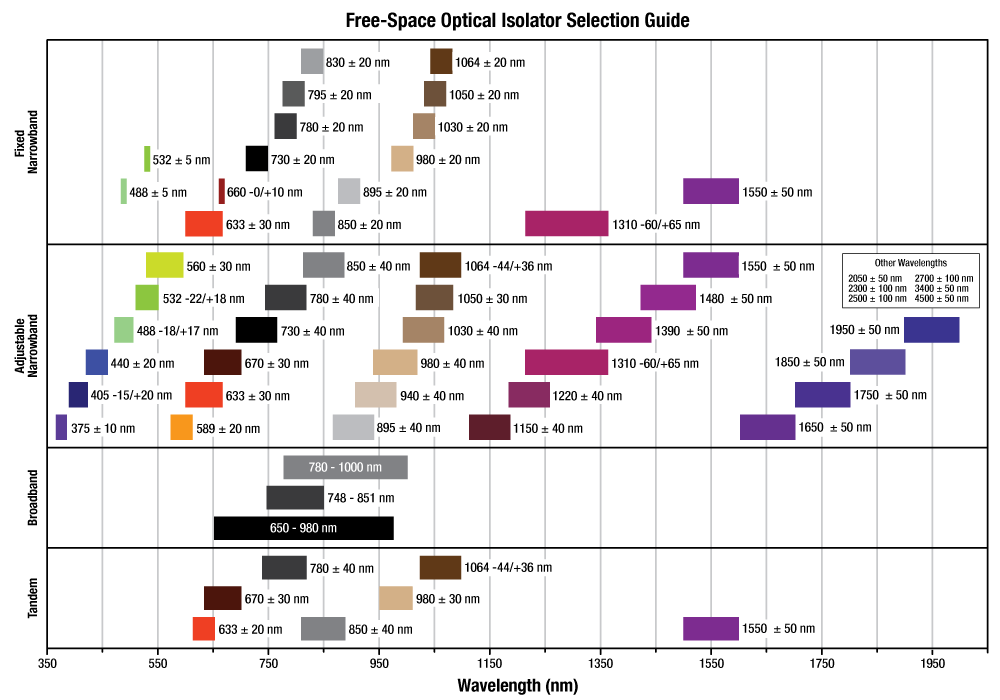

- Center Wavelength Adjustable Across >200 nm Wavelength Range
- Greater Isolation and Transmission than Fixed Broadband Isolators
Thorlabs' Adjustable Broadband Isolators offer the ability to tune the center wavelength of the instruments for peak isolation over a very broad range of over 200 nm. They offer higher isolation and transmission than fixed broadband isolators (sold below), but they have a narrower operating wavelength range once the center wavelength is set. Custom adjustable broadband isolators are available by contacting Tech Sales.

- Flat Isolation and Transmission over Broad ~100 nm Wavelength Range
- Hands-Off Operation; No Adjustment Required
Thorlabs' Fixed Broadband Isolator offers a very broad ~100 nm operating wavelength range centered at 800 nm. The flat isolation and transmission of this isolator across this broad range helps to preserve the temporal shape of short laser pulses. The center wavelength of this isolator is fixed for simple operation with no required tuning or adjustments. Custom fixed broadband isolators are available by contacting Tech Sales.
| Click Image for Details | 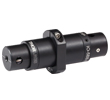 |
| Item # | IO-5BB-800-HPa |
| Type | Fixed Broadband |
| Center Wavelength | 800 nm |
| Tuning Range | N/A |
| Operating Range | 748 - 851 nm |
| Transmission | 88% |
| Isolation | 30 dB (Min) |
| Performance Graph (Click for Details) |
|
| Max Beam Diameterb | 4.5 mm |
| Max Powerc | 35 W |
| Max Power Density | 500 W/cm2 |
| Compatible Mounting Adaptersd |
CP36 SM1RCe (SM1RC/M) SM1TC SM2A21 |

These adapters provide mechanical compatibility between our isolator bodies and SM2 (2.035"-40) lens tubes, 30 mm cage systems, or Ø1/2" posts.
 Products Home
Products Home













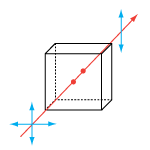
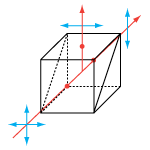
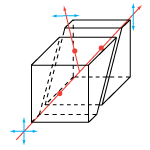
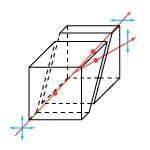
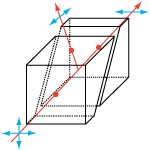
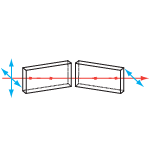

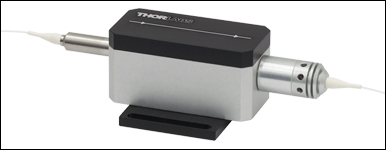

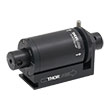




 Broadband Free-Space Isolators
Broadband Free-Space Isolators